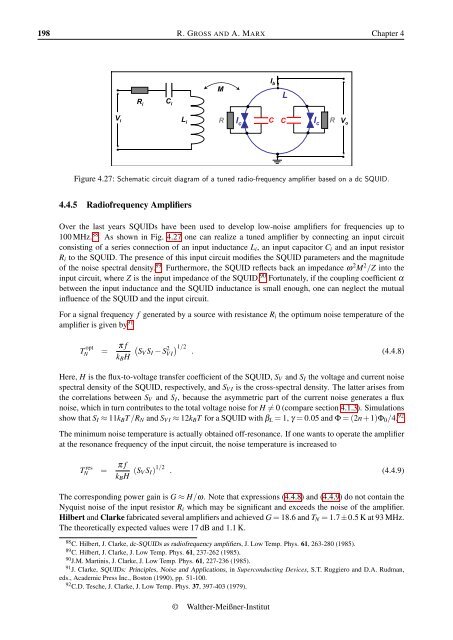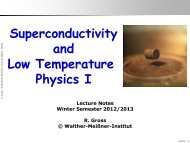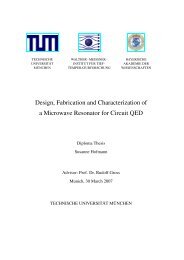Applied Superconductivity - Walther Meißner Institut - Bayerische ...
Applied Superconductivity - Walther Meißner Institut - Bayerische ...
Applied Superconductivity - Walther Meißner Institut - Bayerische ...
- No tags were found...
You also want an ePaper? Increase the reach of your titles
YUMPU automatically turns print PDFs into web optimized ePapers that Google loves.
198 R. GROSS AND A. MARX Chapter 4R iC iMI bLV iL iRI cCCI cRV oFigure 4.27: Schematic circuit diagram of a tuned radio-frequency amplifier based on a dc SQUID.4.4.5 Radiofrequency AmplifiersOver the last years SQUIDs have been used to develop low-noise amplifiers for frequencies up to100 MHz. 88 As shown in Fig. 4.27 one can realize a tuned amplifier by connecting an input circuitconsisting of a series connection of an input inductance L i , an input capacitor C i and an input resistorR i to the SQUID. The presence of this input circuit modifies the SQUID parameters and the magnitudeof the noise spectral density. 89 Furthermore, the SQUID reflects back an impedance ω 2 M 2 /Z into theinput circuit, where Z is the input impedance of the SQUID. 90 Fortunately, if the coupling coefficient αbetween the input inductance and the SQUID inductance is small enough, one can neglect the mutualinfluence of the SQUID and the input circuit.For a signal frequency f generated by a source with resistance R i the optimum noise temperature of theamplifier is given by 91T optN = π fk B H(SV S I − SV 2 ) 1/2I . (4.4.8)Here, H is the flux-to-voltage transfer coefficient of the SQUID, S V and S I the voltage and current noisespectral density of the SQUID, respectively, and S V I is the cross-spectral density. The latter arises fromthe correlations between S V and S I , because the asymmetric part of the current noise generates a fluxnoise, which in turn contributes to the total voltage noise for H ≠ 0 (compare section 4.1.3). Simulationsshow that S I ≈ 11k B T /R N and S V I ≈ 12k B T for a SQUID with β L = 1, γ = 0.05 and Φ = (2n+1)Φ 0 /4. 92The minimum noise temperature is actually obtained off-resonance. If one wants to operate the amplifierat the resonance frequency of the input circuit, the noise temperature is increased toT resN = π fk B H (S V S I ) 1/2 . (4.4.9)The corresponding power gain is G ≈ H/ω. Note that expressions (4.4.8) and (4.4.9) do not contain theNyquist noise of the input resistor R i which may be significant and exceeds the noise of the amplifier.Hilbert and Clarke fabricated several amplifiers and achieved G = 18.6 and T N = 1.7±0.5 K at 93 MHz.The theoretically expected values were 17 dB and 1.1 K.88 C. Hilbert, J. Clarke, dc-SQUIDs as radiofrequency amplifiers, J. Low Temp. Phys. 61, 263-280 (1985).89 C. Hilbert, J. Clarke, J. Low Temp. Phys. 61, 237-262 (1985).90 J.M. Martinis, J. Clarke, J. Low Temp. Phys. 61, 227-236 (1985).91 J. Clarke, SQUIDs: Principles, Noise and Applications, in Superconducting Devices, S.T. Ruggiero and D.A. Rudman,eds., Academic Press Inc., Boston (1990), pp. 51-100.92 C.D. Tesche, J. Clarke, J. Low Temp. Phys. 37, 397-403 (1979).© <strong>Walther</strong>-Meißner-<strong>Institut</strong>
















